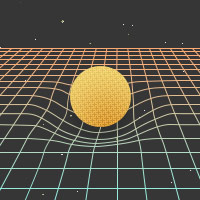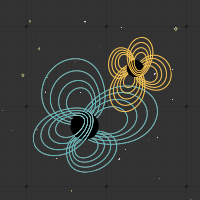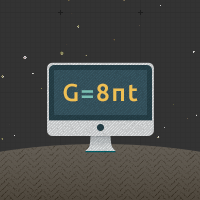Gravitational Waves
Ripples in the Fabric of Space Time
No amount of experimentation can ever prove me right; a single experiment can prove me wrong.
Albert Einstein
In the section on Relativity, we've seen how space and time can curve. Near the Earth, this curvature is fairly constant. The "pull of gravity" we experience is basically the same at any two points in time. There is a gentle variation in the pull, however. This fact is made clear in the existence of ocean tides — changing gravity from the pull of the Sun and the Moon changes the level of water in different parts of the oceans. But we know that the gravitational "pull" is really just curvature of spacetime, so the curvature is changing slightly in time. One of the most interesting predictions of the General Theory of Relativity is that this changing curvature can travel through space, much like a wave across water. If we rotate a paddle in water, waves travel out across the surface of the water. The Earth orbiting the Sun is just like a paddle spinning and stirring up spacetime so that gravitational waves travel out across spacetime.
Reshaping Space

 We can better understand what a gravitational wave is by looking at how it affects anything it passes through. Imagine a ship on water. As a water wave passes from right to left, the ship will rock up and down. If a gravitational wave passes in the same direction, on the other hand, the ship grows taller, then shorter — it waves.
We can better understand what a gravitational wave is by looking at how it affects anything it passes through. Imagine a ship on water. As a water wave passes from right to left, the ship will rock up and down. If a gravitational wave passes in the same direction, on the other hand, the ship grows taller, then shorter — it waves.
These waves have some important features. We are familiar with the idea of the speed of a wave on water—this is just how far the crest of a wave moves per unit time (miles per hour, or meters per second, for example). The same idea applies to a gravitational wave. Here, the crest is the point where the ship is most stretched out. In the picture above, you can watch as this point moves along the ship from right to left. For a real gravitational wave, this speed is always equal to the speed of light. (The gravitational wave is slowed down in these pictures, because it would be very hard to see otherwise.) Another important aspect of these waves is their wavelength. This is just the distance between wave crests.

 We can turn our boat a little to see the waves from a second perspective. Imagine the waves broadsiding the boat. For a water wave, this will just raise and lower the boat, as it rides on the crest and then in the trough of the wave. For a gravitational wave, the ship will be pulled and then pinched, as we see in the pictures.
We can turn our boat a little to see the waves from a second perspective. Imagine the waves broadsiding the boat. For a water wave, this will just raise and lower the boat, as it rides on the crest and then in the trough of the wave. For a gravitational wave, the ship will be pulled and then pinched, as we see in the pictures.
These pictures show one more interesting feature of the waves — their amplitude, or size. For the water wave, this is the distance the ship moves up or down from its center position. For the gravitational wave, this is the percentage of squeeze or stretch by which the wave distorts the ship.
The Sound of a Gravitational Wave
Watch the flag at the top of the ship's bow in the first gravitational wave picture above. As it moves back and forth, it is following a geodesic. Nothing is pushing it back and forth; spacetime is simply warped in such a way that the path it follows is a "straight" line. Notice especially that the distance between the flag and the center of the ship is changing. If that gravitational wave were passing through your head, the same thing would be happening. In particular, the distances between parts of your ears would change. The eardrum would be moving back and forth, for example. But this is just what causes you to experience sound. Could you hear a gravitational wave?
In principle, yes! If the gravitational wave were strong enough, and the sound it made were a pitch humans could hear, then you would hear it passing through you. To be at the right pitch, the wave would have to move the ship's flag up and down at least twenty times per second. Of course, if it were strong enough to be heard, you would probably have other problems. Nonetheless, you could amplify the sounds if you had a microphone that was sensitive enough.
One question is whether anything in Nature makes these sounds at the right pitch, and loud enough, for humans to hear. Astrophysicists have found many sources for sounds that we actually could hear, with a good enough microphone. The next sections will take us through a set of possible sources of gravitational waves which may be heard in coming years. This will provide the strongest test yet for Einstein's ideas about spacetime.






